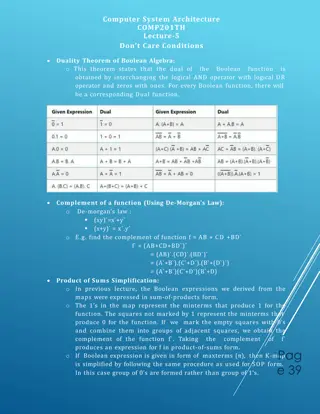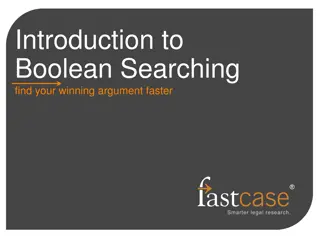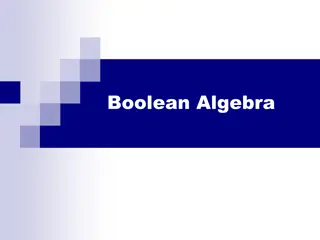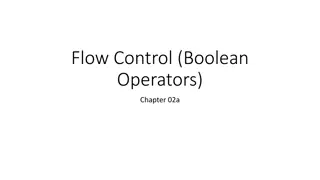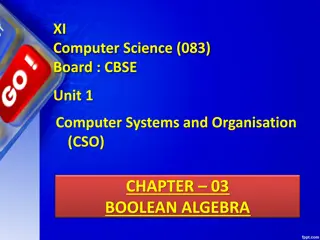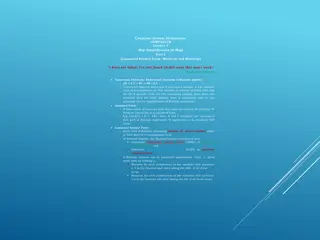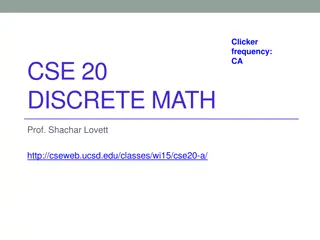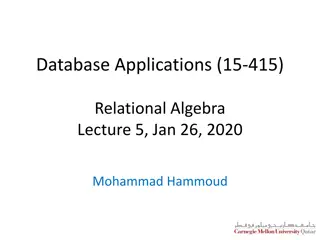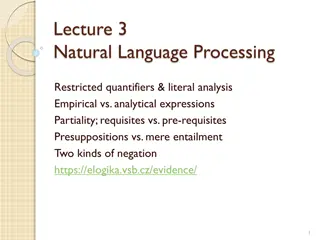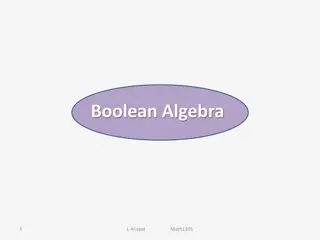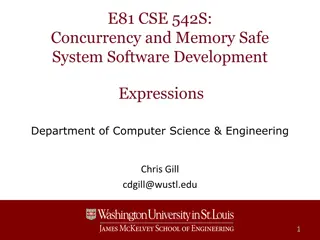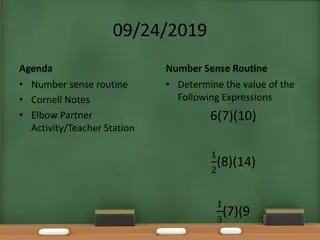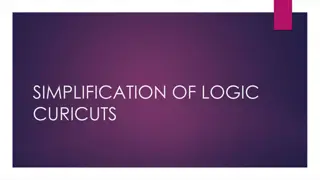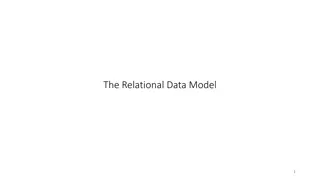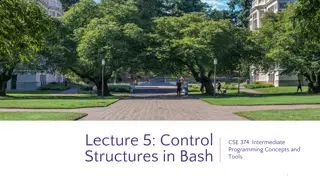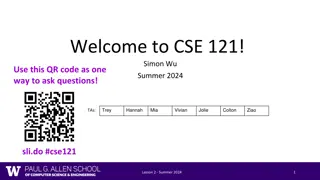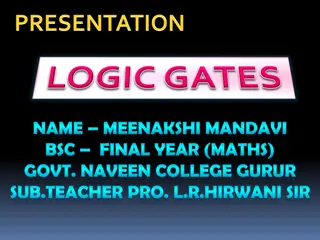Understanding Relational Operations for Boolean Expressions
Learn about relational operations in Boolean expressions through examples and explanations. Discover how to compare numeric operands to produce Boolean results, covering equal to, not equal to, less than, less than or equal to, greater than, and greater than or equal to operations. The content includes programming exercises, relational expressions examples, and the structure of Boolean expressions with parentheses. Explore why certain relational expressions are not recommended and understand the concept of short circuiting in Boolean operations.
Download Presentation

Please find below an Image/Link to download the presentation.
The content on the website is provided AS IS for your information and personal use only. It may not be sold, licensed, or shared on other websites without obtaining consent from the author. Download presentation by click this link. If you encounter any issues during the download, it is possible that the publisher has removed the file from their server.
E N D
Presentation Transcript
Boolean Data Lesson #2 Outline 11. 12. 13. 14. 15. 16. 17. 18. 19. 20. 21. 22. 23. 24. Relational Expressions Example #1 Relational Expressions Example #2 Relational Expressions Example #3 Relational Expressions Example #4 Relational Expressions Example #5 Relational Expressions Example #6 Relational Expressions Example #7 Why Not Use a < b < c? #1 Why Not Use a < b < c? #2 Short Circuiting Short Circuit Example #1 Short Circuit Example #2 Short Circuit Example #3 Programming Exercise 1. 2. 3. 4. 5. 6. Relational Operations #1 Relational Operations #2 Relational Expressions Example #1 Relational Expressions Example #2 Structure of Boolean Expressions Boolean Expressions with Parentheses Precedence Order of Boolean Operations Boolean Precedence Order Example #1 Boolean Precedence Order Example #2 Boolean Precedence Order Example 7. 8. 9. 10. Boolean Data Lesson #2 CS1313 Fall 2024 1
Relational Operations #1 A relationaloperation is a binary operation that compares two numeric operands and produces a Boolean result. For example: CS1313_lab_section == 14 cm_per_km != 100 age < 21 number_of_students <= number_of_chairs credit_hours_completed > 30 electoral_votes >= 270 Boolean Data Lesson #2 CS1313 Fall 2024 2
Relational Operations #2 Operation Operator Usage Result x == y 1 if the value of x is exactly the same as the value of y; otherwise 0 x != y 1 if the value of x is different from the value of y; otherwise 0 x < y 1 if the value of x is less than the value of y; otherwise 0 x <= y 1 if the value of x is less than or equal to the value of y; otherwise 0 x > y 1 if the value of x is greater than the value of y; otherwise 0 x >= y 1 if the value of x is greater than or equal to the value of y; otherwise 0 == Equal to != Not equal to < Less than <= Less than or equal to Greater than > >= Greater than or equal to Boolean Data Lesson #2 CS1313 Fall 2024 3
Relational Expressions Example #1 #include <stdio.h> int main () { /* main */ int CS1313_size, METR1313_size; printf("How many students are in CS1313?\n"); scanf("%d", &CS1313_size); printf("How many students are in METR1313?\n"); scanf("%d", &METR1313_size); printf("%d == %d: %d\n", CS1313_size, METR1313_size, CS1313_size == METR1313_size); printf("%d != %d: %d\n", CS1313_size, METR1313_size, CS1313_size != METR1313_size); printf("%d < %d: %d\n", CS1313_size, METR1313_size, CS1313_size < METR1313_size); printf("%d <= %d: %d\n", CS1313_size, METR1313_size, CS1313_size <= METR1313_size); printf("%d > %d: %d\n", CS1313_size, METR1313_size, CS1313_size > METR1313_size); printf("%d >= %d: %d\n", CS1313_size, METR1313_size, CS1313_size >= METR1313_size); } /* main */ Boolean Data Lesson #2 CS1313 Fall 2024 4
Relational Expressions Example #2 % gcc -o relational relational.c % relational How many students are in CS1313? 136 How many students are in METR1313? 43 136 == 43: 0 136 != 43: 1 136 < 43: 0 136 <= 43: 0 136 > 43: 1 136 >= 43: 1 Boolean Data Lesson #2 CS1313 Fall 2024 5
Structure of Boolean Expressions A Boolean expression can be long and complicated. For example: a || (b || c && !d) && e && (f || g) && h Terms and operators can be mixed together in almost limitless variety, but they must follow these rules: a unary operator has a term immediately to its right, and a binary operator has terms on both its left and its right. Boolean Data Lesson #2 CS1313 Fall 2024 6
Boolean Expressions with Parentheses Parentheses can be placed around any unary or binary subexpression: (a || b) || (c && (d && (!e))) Putting a term in parentheses may change the value of the expression, because a term inside parentheses will be calculated first. For example: a || b && c is evaluated as b AND c, OR a, but (a || b) && c is evaluated as a OR b, AND c. Boolean Data Lesson #2 CS1313 Fall 2024 7
Precedence Order of Boolean Operations In the absence of parentheses to explicitly state the order of operations, the order of precedence is: 1. relational operations, left to right 2. !, left to right 3. &&, left to right 4. ||, left to right After taking into account the above rules, the expression as a whole is evaluated left to right. Rule of Thumb: If you can t remember the priority order of the operators, use lots of parentheses. Boolean Data Lesson #2 CS1313 Fall 2024 8
Boolean Precedence Order Example #1 ! 0 || 1 1 || 1 1 but ! (0 || 1) ! 1 0 Boolean Data Lesson #2 CS1313 Fall 2024 9
Boolean Precedence Order Example #2 0 && 1 || 1 && 1 0 || 1 && 1 0 || 1 but || 1 0 && (1 1) && 1 0 && 1 && 1 0 && 1 0 Boolean Data Lesson #2 CS1313 Fall 2024 10
Boolean Precedence Order Example % cat logic_expressions.c #include <stdio.h> int main () { /* main */ printf("! 0 || 1 = %d\n", ! 0 || 1); printf("!(0 || 1) = %d\n", !(0 || 1)); printf("0 && 1 || 1 && 1 = %d\n", 0 && 1 || 1 && 1); printf("0 && (1 || 1) && 1 = %d\n", 0 && (1 || 1) && 1); } /* main */ % gcc -o logic_expressions logic_expressions.c % lgcexpr ! 0 || 1 = 1 !(0 || 1) = 0 0 && 1 || 1 && 1 = 1 0 && (1 || 1) && 1 = 0 Boolean Data Lesson #2 CS1313 Fall 2024 11
Relational Expressions Example #1 #include <stdio.h> int main () { /* main */ const int program_success_code = 0; int a, b, c; char b_equals_a, b_equals_c; char b_between_a_and_c, b_between_c_and_a; char b_outside_a_and_c; char a_lt_b_lt_c, c_lt_b_lt_a; Boolean Data Lesson #2 CS1313 Fall 2024 12
Relational Expressions Example #2 printf("Enter three different integers:\n"); scanf("%d %d %d", &a, &b, &c); printf("The integers you entered are:\n"); printf("a = %d, b = %d, c = %d\n", a, b, c); b_equals_a = (b == a); b_equals_c = (b == c); b_between_a_and_c = ((a < b) && (b < c)); b_between_c_and_a = ((c < b) && (b < a)); b_outside_a_and_c = !(b_between_a_and_c || b_between_c_and_a); a_lt_b_lt_c = a < b < c; c_lt_b_lt_a = c < b < a; printf("b == a: %d\n", b_equals_a); printf("b == c: %d\n", b_equals_c); printf("a < b && b < c: %d\n", b_between_a_and_c); printf("c < b && b < a: %d\n", b_between_c_and_a); printf("a < b < c: %d\n", a_lt_b_lt_c); printf("c < b < a: %d\n", c_lt_b_lt_a); printf("b outside a and c: %d\n", b_outside_a_and_c); return program_success_code; } /* main */ Boolean Data Lesson #2 CS1313 Fall 2024 13
Relational Expressions Example #3 % gcc -o comparisons comparisons.c % comparisons Enter three different integers: 4 4 5 The integers you entered are: a = 4, b = 4, c = 5 b == a: 1 b == c: 0 a < b && b < c: 0 c < b && b < a: 0 a < b < c: 1 c < b < a: 1 b outside a and c: 1 Boolean Data Lesson #2 CS1313 Fall 2024 14
Relational Expressions Example #4 % comparisons Enter three different integers: 4 5 5 The integers you entered are: a = 4, b = 5, c = 5 b == a: 0 b == c: 1 a < b && b < c: 0 c < b && b < a: 0 a < b < c: 1 c < b < a: 1 b outside a and c: 1 Boolean Data Lesson #2 CS1313 Fall 2024 15
Relational Expressions Example #5 % comparisons Enter three different integers: 4 5 6 The integers you entered are: a = 4, b = 5, c = 6 b == a: 0 b == c: 0 a < b && b < c: 1 c < b && b < a: 0 a < b < c: 1 c < b < a: 1 b outside a and c: 0 Boolean Data Lesson #2 CS1313 Fall 2024 16
Relational Expressions Example #6 % comparisons Enter three different integers: 6 5 4 The integers you entered are: a = 6, b = 5, c = 4 b == a: 0 b == c: 0 a < b && b < c: 0 c < b && b < a: 1 a < b < c: 1 c < b < a: 1 b outside a and c: 0 Boolean Data Lesson #2 CS1313 Fall 2024 17
Relational Expressions Example #7 % comparisons Enter three different integers: 4 3 5 The integers you entered are: a = 4, b = 3, c = 5 b == a: 0 b == c: 0 a < b && b < c: 0 c < b && b < a: 0 a < b < c: 1 c < b < a: 1 b outside a and c: 1 Boolean Data Lesson #2 CS1313 Fall 2024 18
Why Not Use a < b < c? #1 b_between_a_and_c = ((a < b) && (b < c)); b_between_c_and_a = ((c < b) && (b < a)); b_outside_a_and_c = !(b_between_a_and_c || b_between_c_and_a); a_lt_b_lt_c = a < b < c; c_lt_b_lt_a = c < b < a; Expressions like a < b < c and c < b < a WON T accomplish what they look like they should. Why not? Boolean Data Lesson #2 CS1313 Fall 2024 19
Why Not Use a < b < c? #2 Consider the expression a < b < c, and suppose that a is 6, b is 5 and c is 4; that is, 6 < 5 < 4, which we know in real life is false. But let s evaluate the expression as written. 1. Using the precedence rules, we evaluate left to right, so first we evaluate the subexpression a < b, which is a relational expression, so its result must be true (1) or false (0) in this case false (0). 2. We then plug that result into the rest of the expression, getting 0 < c; that is, 0 < 4, which is true so the value for a < b < c is wrong! Instead, we need to use this: (a < b) && (b < c) Boolean Data Lesson #2 CS1313 Fall 2024 20
Short Circuiting When a C program evaluates a Boolean expression, it may happen that, after evaluating some of the terms, the result can no longer change, regardless of what the remaining terms evaluate to. In that case, the program will stop bothering to evaluate the rest of the expression, because evaluating the rest of the expression wouldn t make any difference, but would waste time. In such a case, we say that the Boolean expression will short circuit: the rest of the expression won t be evaluated, because evaluating it would waste time, given that it won t change the result. Boolean Data Lesson #2 CS1313 Fall 2024 21
Short Circuit Example #1 #include <stdio.h> int main () { /* main */ const int maximum_short_height_in_cm = 170; const int program_success_code = 0; int my_height_in_cm = 160; char I_am_Henry = 1; char I_am_tall; char my_middle_initial = 'J'; I_am_tall = (!I_am_Henry) && (my_height_in_cm > maximum_short_height_in_cm); printf("I_am_Henry = %d\n", I_am_Henry); printf("my_height_in_cm = %d\n", my_height_in_cm); printf("I_am_tall = %d\n", I_am_tall); printf("my_middle_initial = %c\n", my_middle_initial); return program_success_code; } /* main */ Boolean Data Lesson #2 CS1313 Fall 2024 22
Short Circuit Example #2 % gcc -o short_circuit short_circuit.c % short_circuit I_am_Henry = 1 my_height_in_cm = 160 I_am_tall = 0 my_middle_initial = J In the example above, the relational expression never gets evaluated, because the first operand in the AND operation && evaluates to 0, and therefore the entire AND operation must evaluate to 0. Boolean Data Lesson #2 CS1313 Fall 2024 23
Short Circuit Example #3 int my_height_in_cm = 160; char I_am_Henry = 1; char I_am_tall; I_am_tall = (!I_am_Henry) && (my_height_in_cm < maximum_short_height_in_cm); In the example above, the relational expression never gets evaluated, because the first operand in the AND operation && evaluates to 0, and therefore the entire AND operation must evaluate to 0. Boolean Data Lesson #2 CS1313 Fall 2024 24
Programming Exercise Write a program to determine which of three floating point values is the greatest. The program should: 1. Greet the user. 2. Prompt for and input each of the three values. 3. Determine the greatest. 4. Output the first value, and whether it s the greatest. 5. Output the second value, and whether it s the greatest. 6. Output the third value, and whether it s the greatest. Boolean Data Lesson #2 CS1313 Fall 2024 25


